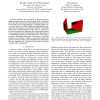Free Online Productivity Tools
i2Speak
i2Symbol
i2OCR
iTex2Img
iWeb2Print
iWeb2Shot
i2Type
iPdf2Split
iPdf2Merge
i2Bopomofo
i2Arabic
i2Style
i2Image
i2PDF
iLatex2Rtf
Sci2ools
ICRA
2005
IEEE
2005
IEEE
Using Hierarchical EM to Extract Planes from 3D Range Scans
— Recently, the acquisition of three-dimensional maps has become more and more popular. This is motivated by the fact that robots act in the three-dimensional world and several tasks such as path planning or localizing objects can be carried out more reliable using three-dimensional representations. In this paper we consider the problem of extracting planes from three-dimensional range data. In contrast to previous approaches our algorithm uses a hierarchical variant of the popular Expectation Maximization (EM) algorithm [1] to simultaneously learn the main directions of the planar structures. These main directions are then used to correct the position and orientation of planes. In practical experiments carried out with real data and in simulations we demonstrate that our algorithm can accurately extract planes and their orientation from range data. I. I Whereas mobile robots act in the three-dimensional world, most of the research regarding spatial r...
Related Content
| Added | 25 Jun 2010 |
| Updated | 25 Jun 2010 |
| Type | Conference |
| Year | 2005 |
| Where | ICRA |
| Authors | Rudolph Triebel, Wolfram Burgard, Frank Dellaert |
Comments (0)

